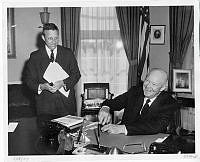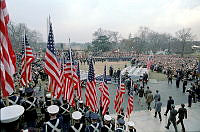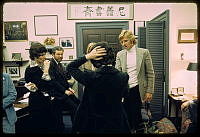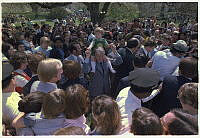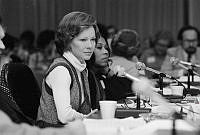Noah Brooks and the Lincoln White House
Copyright © March 10, 2015 White House Historical Association. All rights reserved under international copyright conventions. No part of this article may be reproduced or utilized in any form or by any means, electronic or mechanical, including photocopying, recording, or by any information storage and retrieval system, without permission in writing from the publisher. Requests for reprint permissions should be addressed to books@whha.org
Although President Abraham Lincoln had friends and supporters in the press such as Pennsylvania newspaper editor John Forney; Henry J. Raymond, editor and owner of the New York Times; and Lawrence A. Gobright of the Associated Press, probably none was closer to him than Noah Brooks (1830-1903), the Washington, D.C. reporter for the Sacramento, California Daily Union. The two men first met in July 1856 at a political rally in Dixon, Illinois, where Lincoln was working for the Republican presidential candidacy of John C. Fremont, and soon developed a heartfelt friendship. Brooks was 21 years younger than Lincoln and some believed Lincoln saw him as almost a surrogate son.1

An 1860s view of the White House featuring the bronze statue of Thomas Jefferson by Pierre-Jean David d’Angers on the North Lawn; it stood there from 1848 until 1875 when it was moved to the U.S. Capitol. Photograph by Mathew Brady.
White House Historical Association/White House CollectionBrooks liked the Lincoln family, was liked by them, and witnessed some of the most triumphant moments of the Lincoln White House – and some of the most poignant. He had a special place in his heart for Tad Lincoln, a boy with “a warm heart and a tender conscience,” who would often come to his father’s office at evening to excitedly tell of his day. Slowly the quickness of Tad’s words receded, and as he fell into a tired slumber, the president pushed himself away from his desk and tenderly carried his sleeping son to bed.2
In April 1863, Brooks accompanied Lincoln, First Lady Mary Lincoln, and Tad on a visit to the Army of the Potomac headquarters of General Joseph Hooker. He noted that Lincoln touched his hat to officers but removed it in the presence of enlisted men. After the lengthy day of reviewing the troops, Lincoln admitted to Brooks, “It is a great relief to get away from Washington and the politicians. But nothing touches the tired spot.”3

President Abraham Lincoln and his son Tad, then 11 years old, photographed by Alexander Gardner, Washington, D.C., February 5, 1865.
Library of CongressDuring winter public receptions were held, usually in the Blue Room or the East Room, and Brooks observed that the crowds were so numerous and Lincoln shook so many hands that “the white kid glove of his right hand, when the operation of handshaking was over, always looked as if it had been dragged through a dust-bin. Much of the time, I think, the President never heard with his inner ear the names of persons presented to him … His thoughts were apt to be far from the crowds of strangers that passed before him.”4
On May 6, 1863 Brooks was in the White House chatting with Washington Territorial Governor A.C. Henry when the president entered the room, his face ashen. Lincoln handed Brooks a telegram, “and in a voice trembling with emotion, said, “Read it – news from the army.” The telegram told of the Union defeat at the Battle of Chancellorsville. Remembered Brooks: “The appearance of the President, as I read aloud these fateful words, was piteous. Never, as long as I knew him, did he seem to be so broken, so dispirited, and so ghostlike. Clasping his hands behind his back, he walked up and down the room, saying, “My God! My God! What will the country say! What will the country say!”5

Major General Joseph Hooker (1814-1879), who commanded the Army of the Potomac during January-June 1863.
On the morning of Election Day 1864, Lincoln confided to Brooks: “[A]bout this thing I am far from being certain; I wish I were certain.” Brooks was one of a small group who joined Lincoln on election night at the War Department telegraph office to receive up-to-the-minute returns. When some encouraging results began coming in, Lincoln had them sent quickly to the White House, saying of the first lady: “She is more anxious than I.” During the long night Lincoln told jokes to relieve the tension and at one point dished out fried oysters to his hungry companions.6

President Lincoln’s second inaugural reception was held in the White House East Room on March 4, 1865. Published by John A. Smith, Philadelphia, Pennsylvania.
Library of CongressShortly after 8:00 p.m. on April 14, 1865, Brooks joined a small group of the president’s friends and associates under the North Portico of the White House to see the Lincolns off on their theater engagement. The next morning Brooks’ landlord told him the tragic news of the president’s assassination. “I sank back into my bed,” he recalled, “cold and shivering with horror, and for a time it seemed as though the end of all things had come.” Outside on “the bleak and cheerless April morning … tears of rain fell from the moist and somber sky. The wind sighed mournfully through streets crowded with sad-faced people[.]” As he walked on F Street in the direction of Ford’s Theater, Brooks noticed a group of officers and soldiers escorting Lincoln’s body back to the White House.7

A Civil War-era photograph of visitors in front of the White House, by an unknown photographer, c. 1860-1865.
Office of the Curator, The White HouseThe heartbreak was particularly deep for Noah Brooks, for with the support of Mary Lincoln he had been scheduled to join the president’s staff as a personal secretary. Although Brooks never worked directly for Lincoln, his observations and descriptions of Lincoln in the White House are an irreplaceable glimpse of the humanity of the Civil War president.














